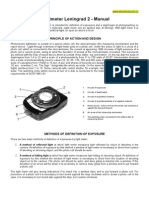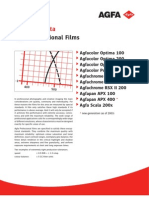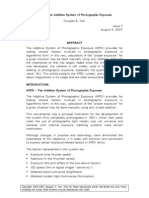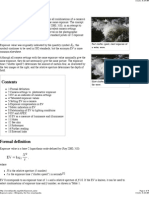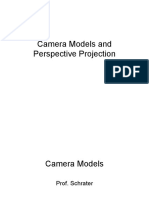01/20/11
Projective Geometry and Camera Models
Computer Vision CS 543 / ECE 549 University of Illinois Derek Hoiem
�Administrative Stuff
Office hours
Derek: Wed 4-5pm + drop by Ian: Mon 3-4pm, Thurs 3:30-4:30pm
HW 1: out Monday
Prob1: Geometry, today and Tues Prob2: Lighting, next Thurs Prob3: Filters, following week
Next Thurs: Im out, David Forsyth will cover
�Last class: intro
Overview of vision, examples of state of art Logistics
�Next two classes: Single-view Geometry
How tall is this woman? How high is the camera? What is the camera rotation? What is the focal length of the camera?
Which ball is closer?
�Todays class
Mapping between image and world coordinates
Pinhole camera model Projective geometry
Vanishing points and lines
Projection matrix
�Image formation
Lets design a camera
Idea 1: put a piece of film in front of an object Do we get a reasonable image?
Slide source: Seitz
�Pinhole camera
Idea 2: add a barrier to block off most of the rays
This reduces blurring The opening known as the aperture
Slide source: Seitz
�Pinhole camera
f
f = focal length c = center of the camera
Figure from Forsyth
�Camera obscura: the pre-camera
First idea: Mo-Ti, China (470BC to 390BC) First built: Alhacen, Iraq/Egypt (965 to 1039AD)
Illustration of Camera Obscura
Freestanding camera obscura at UNC Chapel Hill
Photo by Seth Ilys
�Camera Obscura used for Tracing
Lens Based Camera Obscura, 1568
�First Photograph
Oldest surviving photograph
Took 8 hours on pewter plate
Photograph of the first photograph
Joseph Niepce, 1826
Stored at UT Austin
Niepce later teamed up with Daguerre, who eventually created Daguerrotypes
�Dimensionality Reduction Machine (3D to 2D)
3D world 2D image
Point of observation
Figures Stephen E. Palmer, 2002
�Projection can be tricky
Slide source: Seitz
�Projection can be tricky
Slide source: Seitz
�Projective Geometry
What is lost?
Length
Who is taller?
Which is closer?
�Length is not preserved
A C B
Figure by David Forsyth
�Projective Geometry
What is lost?
Length Angles
Parallel?
Perpendicular?
�Projective Geometry
What is preserved?
Straight lines are still straight
�Vanishing points and lines
Parallel lines in the world intersect in the image at a vanishing point
�Vanishing points and lines
Vanishing Point Vanishing Line
Vanishing Point
�Vanishing points and lines
Vertical vanishing point (at infinity) Vanishing line
Vanishing point
Vanishing point
Slide from Efros, Photo from Criminisi
�Vanishing points and lines
Photo from online Tate collection
�Note on estimating vanishing points
Use multiple lines for better accuracy but lines will not intersect at exactly the same point in practice One solution: take mean of intersecting pairs bad idea! Instead, minimize angular differences
�Vanishing objects
�Projection: world coordinatesimage coordinates
Optical Center (u0, v0)
.
f
.
Camera Center (tx, ty, tz)
X P = Y Z
u p= v
�Homogeneous coordinates
Conversion
Converting to homogeneous coordinates
homogeneous image coordinates
homogeneous scene coordinates
Converting from homogeneous coordinates
�Homogeneous coordinates
Invariant to scaling
x kx kx x kw w k y = ky ky = y kw w w kw
Homogeneous Coordinates Cartesian Coordinates
Point in Cartesian is ray in Homogeneous
�Basic geometry in homogeneous coordinates
ai Line equation: ax + by + c = 0 linei = b i ci Append 1 to pixel coordinate to get ui homogeneous coordinate pi = v i 1
Line given by cross product of two points
lineij = pi p j
Intersection of two lines given by cross product of the lines qij = linei line j
�Another problem solved by homogeneous coordinates
Intersection of parallel lines
Cartesian: (Inf, Inf) Homogeneous: (1, 1, 0) Cartesian: (Inf, Inf) Homogeneous: (1, 2, 0)
�Projection matrix
R,T
Slide Credit: Saverese
jw kw Ow iw
x = K[R t ] X
x: Image Coordinates: (u,v,1) K: Intrinsic Matrix (3x3) R: Rotation (3x3) t: Translation (3x1) X: World Coordinates: (X,Y,Z,1)
�Interlude: when have I used this stuff?
�When have I used this stuff?
Object Recognition (CVPR 2006)
�When have I used this stuff?
Single-view reconstruction (SIGGRAPH 2005)
�When have I used this stuff?
Getting spatial layout in indoor scenes (ICCV 2009)
�When have I used this stuff?
Inserting photographed objects into images (SIGGRAPH 2007)
Original
Created
�When have I used this stuff?
Inserting synthetic objects into images
�Projection matrix
Intrinsic Assumptions Extrinsic Assumptions No rotation Unit aspect ratio
Optical center at (0,0) No skew Camera at (0,0,0)
K
x = K [I 0] X
Slide Credit: Saverese
u f wv = 0 1 0
0 f 0
x 0 0 y 0 0 z 1 0 1
�Remove assumption: known optical center
Intrinsic Assumptions Extrinsic Assumptions No rotation Unit aspect ratio
No skew Camera at (0,0,0)
x = K [I 0] X
u f wv = 0 1 0
0 f 0
u0 v0 1
x 0 y 0 z 0 1
�Remove assumption: square pixels
Intrinsic Assumptions Extrinsic Assumptions
No skew No rotation Camera at (0,0,0)
x = K [I 0] X
u wv = 0 1 0
u0 v0 1
x 0 y 0 z 0 1
�Remove assumption: non-skewed pixels
Intrinsic Assumptions Extrinsic Assumptions
No rotation Camera at (0,0,0)
x = K [I 0] X
u wv = 0 1 0
u0 v0 1
x 0 y 0 z 0 1
Note: different books use different notation for parameters
�Oriented and Translated Camera
R
jw
t
Ow iw
kw
�Allow camera translation
Intrinsic Assumptions Extrinsic Assumptions
No rotation
x = K [I t ] X
u wv = 0 1 0
x u0 1 0 0 t x y v0 0 1 0 t y z 1 0 0 1 t z 1
�3D Rotation of Points
Slide Credit: Saverese
Rotation around the coordinate axes, counter-clockwise:
0 1 Rx ( ) = 0 cos 0 sin sin cos 0 sin 1 0 0 cos 0 0 0 1
y
p
cos Ry ( ) = 0 sin cos sin Rz ( ) = sin cos 0 0
�Allow camera rotation
x = K [R t ] X
u wv = 0 1 0 s u0 r11 v0 r21 1 r31 r12 r22 r32 r13 r23 r33 x tx y ty z tz 1
�Degrees of freedom
x = K [R t ] X
5 6
u wv = 0 1 0
u0 r11 v0 r21 1 r31
r12 r22 r32
r13 r23 r33
x tx y ty z tz 1
�Vanishing Point = Projection from Infinity
x xR x y p = K[R t ] p = KR y p = K y R z z zR 0
u f wv = 0 1 0 0 f 0 u0 xR v0 y R 1 zR
fxR u= + u0 zR fyR v= + v0 zR
�Orthographic Projection
Special case of perspective projection
Distance from the COP to the image plane is infinite
Image World
Also called parallel projection Whats the projection matrix?
x u 1 0 0 0 y w v = 0 1 0 0 z 1 0 0 0 1 1
Slide by Steve Seitz
�Scaled Orthographic Projection
Special case of perspective projection
Object dimensions are small compared to distance to camera
Image World
u f Also called weak perspective w v = 0 Whats the projection matrix? 1 0
0 f 0
x 0 0 y 0 0 z 0 s 1
Slide by Steve Seitz
�Suppose we have two 3D cubes on the ground facing the viewer, one near, one far.
1. What would they look like in perspective? 2. What would they look like in weak perspective?
Photo credit: GazetteLive.co.uk
�Beyond Pinholes: Radial Distortion
Corrected Barrel Distortion
Image from Martin Habbecke
�Things to remember
Vanishing line
Vertical vanishing point (at infinity)
Vanishing points and vanishing lines Pinhole camera model and camera projection matrix Homogeneous coordinates
Vanishing point
Vanishing point
x = K [R t ] X
�Next class
Applications of camera model and projective geometry
Recovering the camera intrinsic and extrinsic parameters from an image Recovering size in the world Projecting from one plane to another
�Questions
�What about focus, aperture, DOF, FOV, etc?
�Adding a lens
circle of confusion
A lens focuses light onto the film
There is a specific distance at which objects are in focus
other points project to a circle of confusion in the image
Changing the shape of the lens changes this distance
�Focal length, aperture, depth of field
F focal point optical center (Center Of Projection)
A lens focuses parallel rays onto a single focal point
focal point at a distance f beyond the plane of the lens Aperture of diameter D restricts the range of rays
Slide source: Seitz
�The eye
The human eye is a camera
Whats the film?
Iris - colored annulus with radial muscles Pupil - the hole (aperture) whose size is controlled by the iris
photoreceptor cells (rods and cones) in the retina
�Depth of field
Slide source: Seitz
f / 5.6
f / 32
Changing the aperture size or focal length affects depth of field
Flower images from Wikipedia
http://en.wikipedia.org/wiki/Depth_of_field
�Varying the aperture
Slide from Efros
Large aperture = small DOF
Small aperture = large DOF
�Shrinking the aperture
Why not make the aperture as small as possible?
Less light gets through Diffraction effects
Slide by Steve Seitz
�Shrinking the aperture
Slide by Steve Seitz
�Relation between field of view and focal length
Field of view (angle width)
d fov = tan 2f
1
Film/Sensor Width
Focal length
�Dolly Zoom or Vertigo Effect
http://www.youtube.com/watch?v=Y48R6-iIYHs
How is this done?
Zoom in while moving away
http://en.wikipedia.org/wiki/Focal_length



